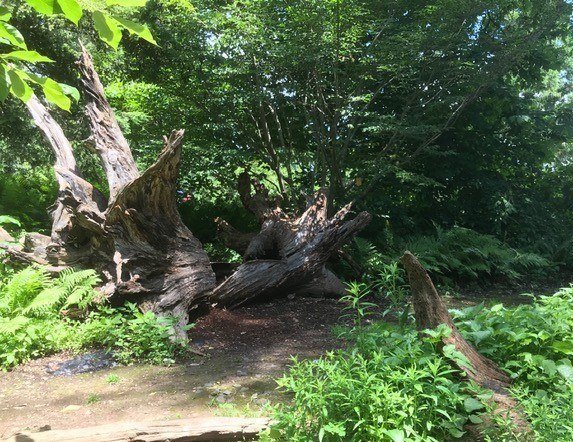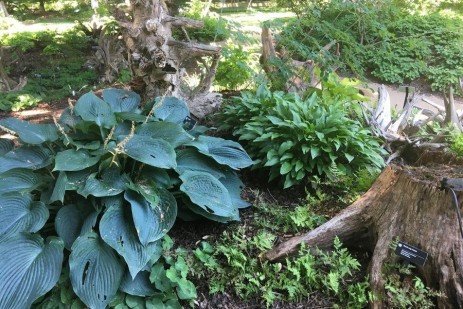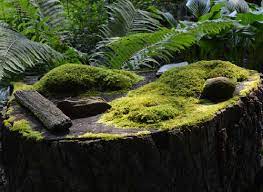Stumpery Basics: New Life for an Old Style
By Elizabeth Cornell Fake, Fairfax Master Gardener
 Your tree had to come down, and now you are stuck with a stump! A stump can be an eyesore, or it can become the focal point for a stumpery, one of the most popular new trends in shade gardening. A stumpery is a garden design planned around interesting pieces of wood that are the focal point and support for the garden. The first stumperies were designed in England about 1856. They gained in popularity when Prince Charles, the Prince of Wales, built his famous stumpery at Highgrove, Gloucestershire, which still exists today. After the death of Queen Victoria, stumperies fell out of fashion in favor of modern styles. But, once again, stumperies are back in style and can lend old-fashioned graciousness and romance to your landscape. You don’t need acres of ground to create a stumpery. A small shady corner of your lot with a few pieces of wood is all you need to get started.
Your tree had to come down, and now you are stuck with a stump! A stump can be an eyesore, or it can become the focal point for a stumpery, one of the most popular new trends in shade gardening. A stumpery is a garden design planned around interesting pieces of wood that are the focal point and support for the garden. The first stumperies were designed in England about 1856. They gained in popularity when Prince Charles, the Prince of Wales, built his famous stumpery at Highgrove, Gloucestershire, which still exists today. After the death of Queen Victoria, stumperies fell out of fashion in favor of modern styles. But, once again, stumperies are back in style and can lend old-fashioned graciousness and romance to your landscape. You don’t need acres of ground to create a stumpery. A small shady corner of your lot with a few pieces of wood is all you need to get started.
What do you use to build a stumpery? Stumperies are made from old tree parts. You can begin with a tree stump or two, or use old tree roots, logs, a rotted-out tree trunk, driftwood, old railroad ties or floorboards. The possibilities are endless, but old wood is better than new. The wood used for the foundation of the stumpery creates the environment and habitat for the plants that will grow there and the wildlife it will attract. Regardless of where you find the wood, the point is to make it look as natural as possible.
 What are the environmental factors to consider in building a stumpery? Under most circumstances, a stumpery is a shade gardening project. It flourishes best in a shade or part shade location where moss will grow easily to cover up all of the rough edges of the wood and give the garden interest than just the plants. Some experts advise a northern exposure with limited sun and a gentle slope. If it is a naturally moist location, it will help to keep maintenance and watering to a minimum.
What are the environmental factors to consider in building a stumpery? Under most circumstances, a stumpery is a shade gardening project. It flourishes best in a shade or part shade location where moss will grow easily to cover up all of the rough edges of the wood and give the garden interest than just the plants. Some experts advise a northern exposure with limited sun and a gentle slope. If it is a naturally moist location, it will help to keep maintenance and watering to a minimum.
How do you start building the stumpery? Gather the wood pieces you want to use and arrange them in a design with the larger pieces in the back and the smaller pieces in the front. Angle the logs to create a natural looking asymmetric design. Next, clear the ground around the foundation pieces. Remove any existing plants or weeds. Aerate and cultivate the soil, augmenting with organic material if the area is highly compacted. Plan to add two to three inches of raised bed topsoil filling in all of the pockets around the wood and around the bed as a whole. Add plants and top with about 2 to 3 inches (5 to 7 cm) of mulch. Water lightly and you are done.

Autumn fern
What kind of plants will work best in a stumpery? Since the stumpery is a woodland setting, start with ferns, hostas and other shade friendly plants. If you have shade plants elsewhere in your garden, consider dividing and adding them here. The chart below lists some good choices. Feel free to plant some bulbs in the fall such as daffodils, snowdrops and scilla to add interest in the spring.
- Wood Fern Dryopteris pulcherrimal
- Shaggy Shield Dryopteris cycadina
- Autumn Fern Dryopteris erythrosora
- Tassel Fern Polystichum polyblepharum
- Hard Shield Fern Polystichum aculeatum
- East Indian Holly Fern Arachnoides simplicior
- Strawberry Geranium Saxifraga stolonifera

Moss covered stump
What about moss? Moss is an essential component of a stumpery. A moss-covered log is much more appealing than a new one, and you want to encourage its abundant growth all over the wood. If the environment of the garden is shady and wet, it will be easy to grow moss, and it will start to grow on its own with little intervention. You can use some pieces of moss purchased from a garden center or divide a piece of moss already in your garden to get the project started. Separate the moss into pieces and distribute them where you want the moss to grow and keep them watered. Some sources advocate concocting a liquid called a buttermilk slurry made from moss and buttermilk, mixing it in a blender and then painting it on the wood. It won’t hurt to do this, but unless you live in a very humid location, it is unlikely it will make much of a difference growing moss.
With the right wood, location, cultivation, plants and moss, you are on your way to having a stumpery you can enjoy with little effort. But watch out; it won’t be yours long. Once established, expect some woodland guests to move into this inviting natural habitat along with insects, toads and mushrooms — all the more reasons to build a stumpery.
References
Creating a Stumpery, Lois Miklas, Pennsylvania State University Extension Service
Growing Moss in Your Garden, Holly Berger, Anoka County, University of Minnesota Extension Service